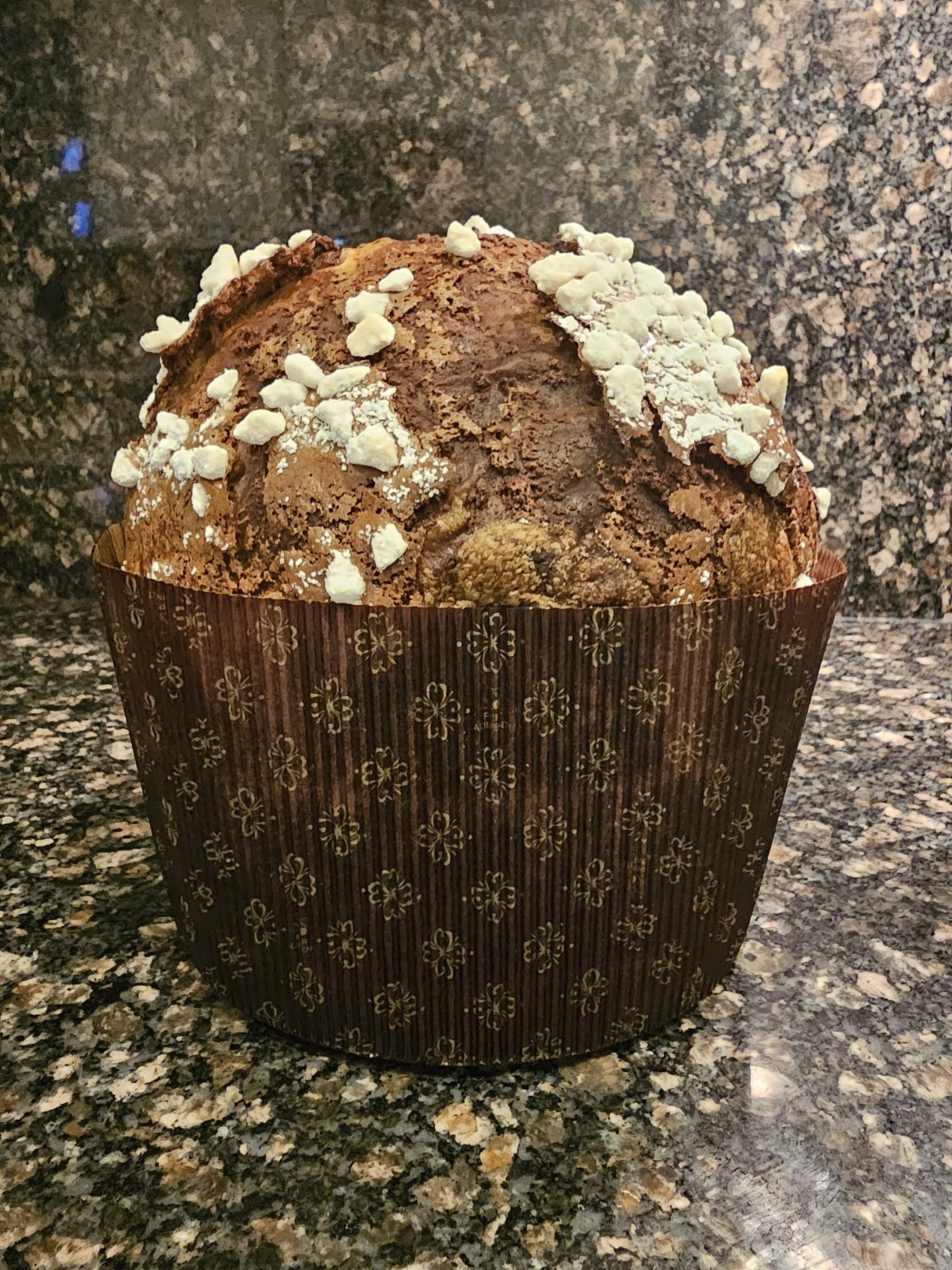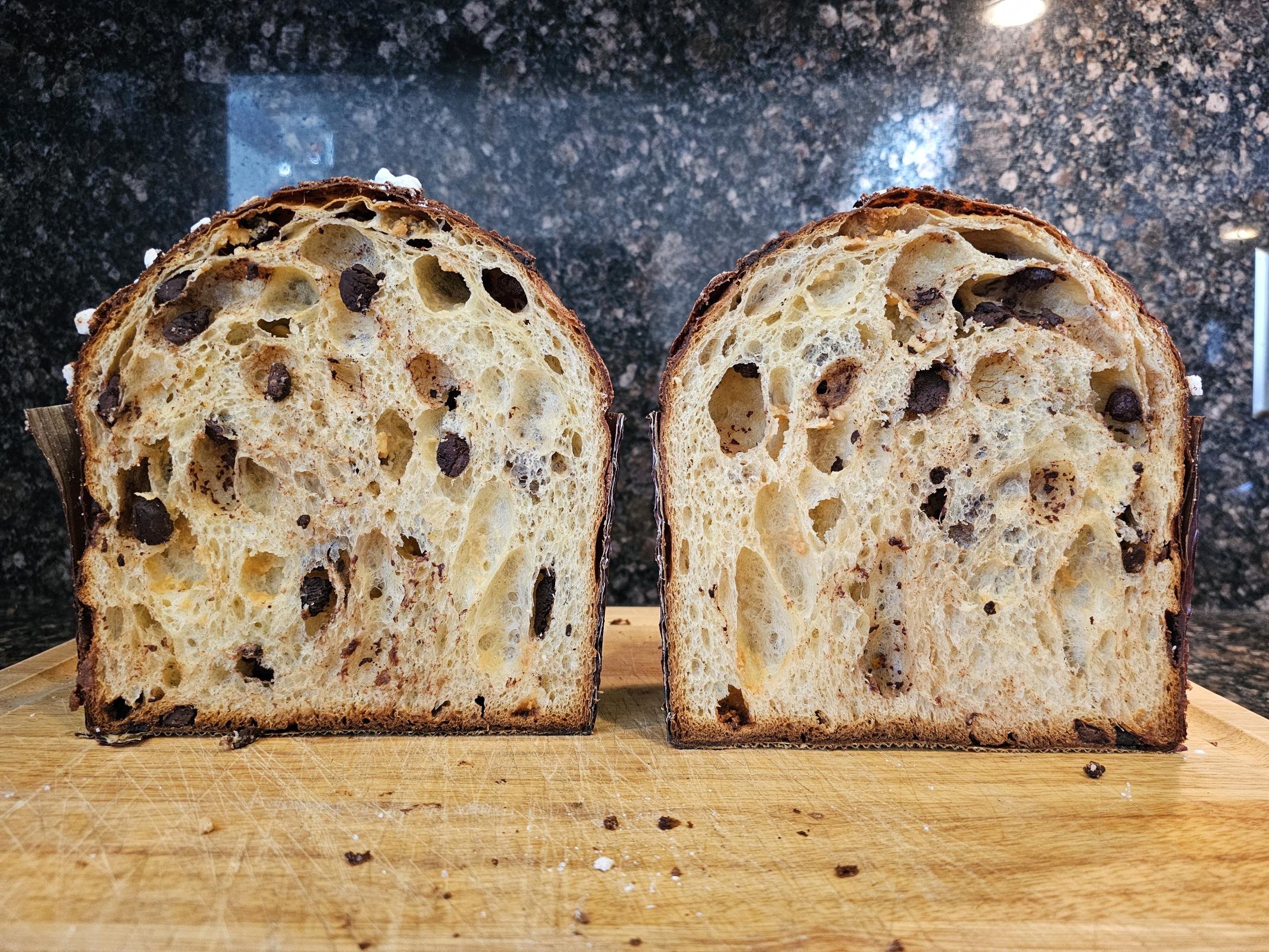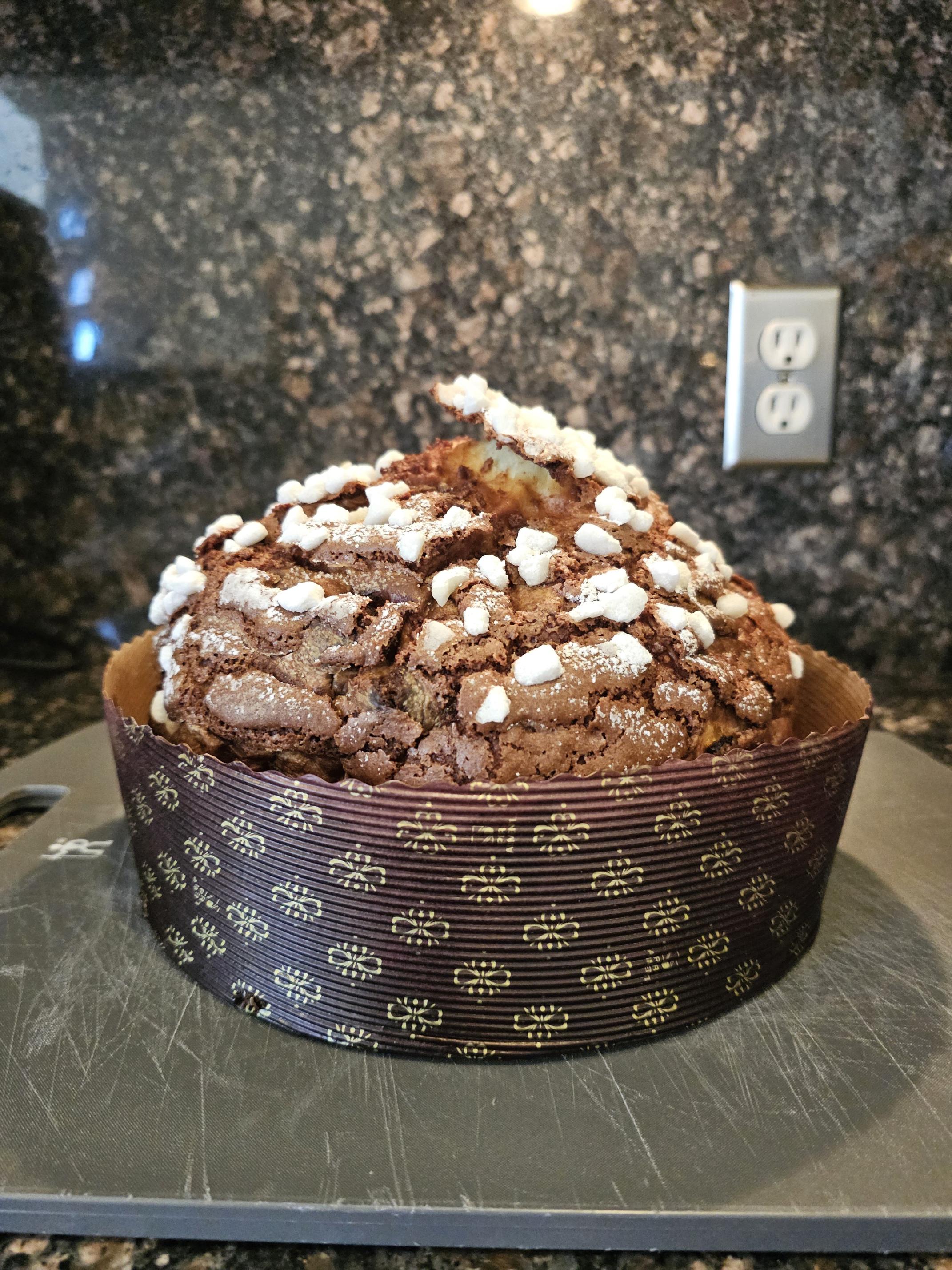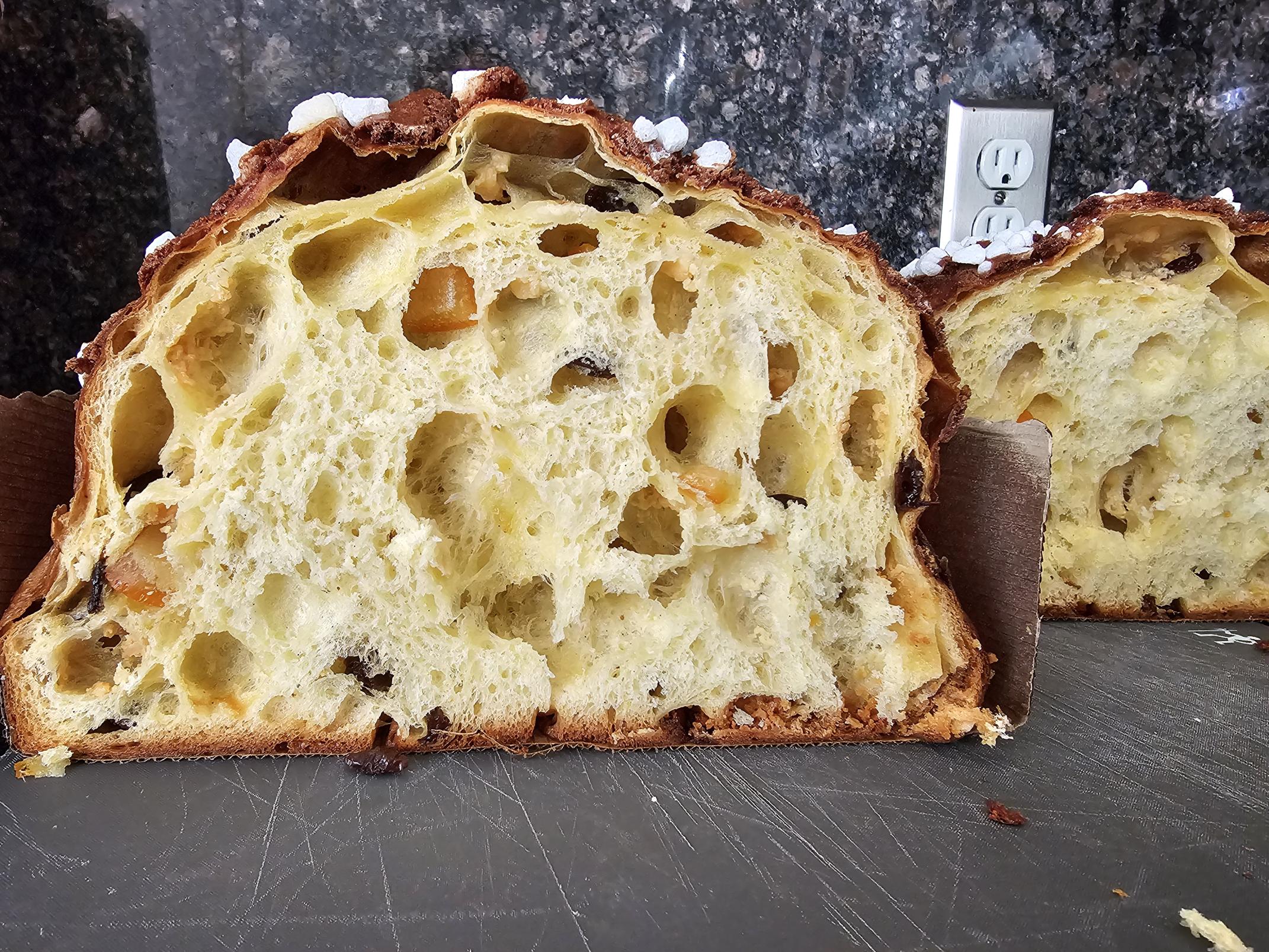It has been a couple of 12 months since I posted my “first” panettone. That was on the finish of 2023 and in 2024, I got down to make panettone each week – that really lasted just a few months till I could not actually handle it anymore. I needed to get artistic, stashing the dough within the fridge if one thing got here up, controlling fermentation with temperature or by shifting sugar between the primary and second doughs, even letting the second dough absolutely proof and placing it within the fridge to bake the subsequent day. I might need damaged some guidelines, however my strategy to creating panettone has aligned extra with how I would strategy making a daily sourdough loaf and fewer with the “inflexible” panettone course of you usually examine.
Pasta Madre
I have been working rather a lot on my pasta madre. A part of the explanation I made a lot panettone was to try to work out this primo acidification subject. After fermentation, the primo needs to be tripled with a pH simply over 5.0 and even as little as 4.6, relying on who you ask. My primo? 4.1 – 4.3. Does that even matter? I feel so. Greater acidity can have an effect on the gluten, which might have an effect on the crumb construction and the peak of the ultimate loaf, to call just a few. In any case, I suppose I will not know for certain how a lot it issues till I repair it.
I exploit King Arthur Bread Flour for my pasta madre and it has by no means behaved like a typical PM. I satisfied myself that my starter was one way or the other particular, that the enriched North American flour I used to be utilizing wasn’t appropriate for a pasta madre, and that the pH readings would inevitably be totally different due to all of this. I nonetheless suppose there could be one thing to that, however I am not utilizing it as an excuse when one thing would not go proper – and actually I did get it beneath management…form of.
My pH values have by no means been proper with this PM. After an evening’s relaxation, the place it needs to be 3.8 – 3.9, I might get 4.1. After a sizzling refreshment, the place you’d anticipate 4.1 I might get 4.3 – 4.6! I could not assist however suppose this was contributing to the acidification subject, so I needed to kind it out. I additionally vaguely bear in mind studying someplace {that a} primo with a really low pH could possibly be brought on by a PM that’s too acetic. A lightbulb went on.
Since my authentic publish right here about my “Panettone Bother”, I’ve handled lactic acid as my mortal enemy when making panettone. I perceive its function and significance, however an excessive amount of of it and the dough will fail, so I started doing all the pieces I might to make my PM as acetic as attainable – in any case, an unsightly or imperfect panettone was higher than none in any respect. Clearly, you possibly can’t utterly get rid of lactic acid (and would not need to), however I believed making an attempt to take action would at the very least end in a extra acetic steadiness than lactic and I would not threat my dough turning to soup. My dough by no means actually failed with this strategy, however maybe I went too far in a single path.
PM Administration
I by no means thought that I might be a type of individuals who says “solely you already know your previous madre”, however right here I’m, cautioning you towards making an attempt something I am about to clarify as a result of it would not completely align with conventional pondering. Take heed to the professionals. I’ve “damaged” my PM, “killed” it so many occasions as a way to determine a few of this out (as easy/apparent as it might appear). I’ve paid in tears (metaphorically – I attempt to not cry over bread).
Right here is my authentic PM administration from earlier than I tried to appropriate any of this:
- Night time Relaxation – 1:1, 40% hydration, free, 18C for 16 – 24hrs. ensuing pH 4.1 – 4.2.
- Sizzling Refreshment – 2:1 (flour:starter), 45% hydration, free, 28C for 4.5 – 6hrs. ensuing pH 4.3 – 4.6.
- Off Days – generally would go from evening relaxation/upkeep proper again into upkeep with no sizzling refreshment. I attempted at the very least each few days to work in a sizzling 2:1 refreshment
- Manufacturing – sizzling 2:1 refreshment out of upkeep, then 1:1, then combine primo
My first aim was to get to the suitable pH values, focusing initially on the pH after the evening’s relaxation. It isn’t that I feel 3.8 – 3.9 is a few magical vary that “purifies” the starter (it would, I definitely do not know), simply that if I began that low, possibly I would have a greater likelihood of hitting 4.1 after a sizzling refreshment. The problem was I used to be already form of on the prime of the temperature vary and did not know what else I might modify to extend acidity throughout the identical timeframe. I did not need to go decrease than 1:1 (which means I did not need to use much less flour than starter), so I checked out different areas. What would occur if I simply left it to ferment longer throughout upkeep? I spend quite a lot of time in books and social media studying about these items and I have never usually heard of an evening’s relaxation that lasts longer than 24 hours, so I attempted it and left it for ~48 hours.
After 48 hours, it was proper the place I needed it, between 3.8 and three.9! This additionally corrected the recent refreshments. Beginning with a decrease pH did in reality assist my heat refreshments land round 4.1 – 4.2. I did not love 48 hour upkeep although. Typically, I see a window in my schedule and resolve to bake, however that might be tough with a 48 hour upkeep, so I checked out another issues I might change.
I used to be mixing my PM for upkeep at 40% hydration. Why? As a result of that is what it appeared like everybody else did. It appeared to me that everybody was utilizing decrease hydrations for the evening’s relaxation and better hydrations for heat refreshments. In the meantime my palms and pasta curler have been crying. I do know that fermentation is quicker at greater hydrations. Greater hydrations are additionally mentioned to advertise a extra lactic steadiness. This was precisely what I used to be in search of, so I attempted it and it labored…form of.
If I combine my PM at 45% hydration and let it absolutely rise at room temp, then put at 18C till the subsequent day, the pH is normally about 3.9, or at the very least under 4.0. I am happier with how this PM is behaving so far as its acidity goes, nevertheless it has made zero distinction within the thriller of the acidifying primo.
This is the brand new routine:
- Night time Relaxation– 1:1, 45% hydration, free, 18C. Relaxation at room temp (~22C) till absolutely risen, the ferment at 18C till the subsequent morning. Ensuing pH 3.8 – 3.95
- Sizzling Refreshment – 2:1, 45% hydration, free, 28C for 4.5 – 6hrs. ensuing pH 4.1 – 4.25
- Off Days – just like what I used to be doing earlier than. When I haven’t got time to refresh or I’m mixing the second dough and do not need to should take care of my PM, I am going to take it for the evening’s relaxation earlier than absolutely risen and can go away it at 16C as a substitute of 18C.
- Manufacturing – identical schedule as earlier than, however I am discovering it simpler to land in 4.1 over consecutive heat refreshments in the event that they’re all 1:1. The preliminary 2:1 refreshment takes longer than I would prefer to acidify (possibly it is a clue to additional changes…)
On the whole, I’ve stared viewing my PM as “simply” a starter. I lower out all the PM-specific stuff you usually hear about – submerging the starter in water, tying it in a fabric, bathing it in sugar water, and many others. Now I simply combine it, coil it (I nonetheless do that as a result of I’ve grown accustomed to the way it appears when it is prepared), put it in a container, after which set it at no matter temp I would like. Whereas the pH values are higher now, I am nonetheless questioning if it is “too acetic”.
Once more, when you’re struggling together with your PM, do not simply do what I do. The primary handful of occasions I attempted free administration, my PM turned a ineffective lump of dough that generally wound up within the trash.
Panettone
Given the acidification subject, which has been current in all of my bakes and can probably stay for a while, I needed to see how far I might “push” the dough – how tall of a loaf might I get? How a lot might I open the crumb? How good of a dome might I get? Whereas I used to be baking pretty recurrently, I used to be all the time left with a loaf that had one visible “defect” or one other – just a little flat, just a little quick, just a little lopsided. Nothing main however how have been individuals getting these completely spherical domes each single time?
One other problem was the components. Most of final 12 months I used to be utilizing Giorilli’s components as a result of it is held in fairly excessive regard and is claimed to be forgiving. Making it appears like a proper of passage in a manner. The true problem for me although was Roy’s components. This by no means got here out proper and I used to be most of the time left with a “cakeattone” that , if I used to be fortunate, had simply sufficient power to not fall when hung. Truthfully, it was all the time a catastrophe and shutting the second dough with extra water appeared insane. Should you’ve made this recipe earlier than, you might need skipped the water within the second dough, like I usually did (did not assist lol).
Now, Roy’s components is all I make. The primary time I made it considerably efficiently and tasted it, I nearly cried (nearly. I attempt to not cry over bread). Roy’s panettone was undoubtedly in there someplace. Beneath all the errors/points, you could possibly style it. What modified? Nothing. All the things. I do not know.
I acquired my palms on this e book you could be acquainted with, known as “Open Crumb Mastery” by Trevor J. Wilson. It is a actually fascinating view of how all the totally different steps all through the baking course of can have an effect on the ultimate crumb. With these ideas in thoughts, I adjusted my panettone course of to try to obtain among the objectives I discussed. This is what it appears like…
Panettone Course of
I am pleased to checklist the components and ratios, however when you’ve gotten this far, you most likely know Roy’s components or the place to seek out it. In any case, the components and ratios do not matter all that a lot. I observe the identical course of regardless. Crucial ingredient is the most likely the flour and I have been utilizing Petra 6384 for panettone, although I nonetheless use KABF for all PM refreshments earlier than the primo.
First, I put together my PM for “manufacturing”, as talked about above. After mixing the ultimate refreshment, I put together my primo components by measuring all the pieces out and placing it within the fridge. I warmth the water and sugar till the sugar is dissolved after which put that within the fridge. Flour, eggs, and mixing bowl additionally go within the fridge. Dough hook goes within the freezer. Butter goes within the chiller at 18C. I am utilizing a planetary mixer so I’ve to take precautions to maintain the dough temp low. All through the blending course of for each doughs, I even hold ice packs beneath my mixing bowl to maintain the dough temp down. The dough by no means goes over 22C whereas mixing.
When the PM is prepared, I combine the primo. First, combine the sugar syrup with the starter and flour for about quarter-hour. Subsequent, I add the eggs and blend till the gluten mesh is recovered, then the butter. I go away this all to ferment at no matter random temperature I would like for nevertheless lengthy I would like 🤣. I normally end this within the night, so I am going to go away it at room temp and can throw it within the fermentation field at possibly 24-25C till the morning. I by no means time it – I simply wait till it triples.
As soon as tripled, I put the dough within the fridge for about half-hour whereas I put together the components for the second dough (I attempt to do that the evening earlier than). Identical factor as final time – no matter might be actually chilly goes within the fridge, butter goes within the chiller, and a few stuff stays at room temp (just like the orange paste and honey).
Then, I combine the second dough. Simply the standard right here. First, I combine the primary dough with the flour for about quarter-hour, then I add the sugar and vanilla (I combine them collectively) and after it is dissolved, the honey. After that, I add the yolks. As soon as yolks are included, I add the salt, adopted by the butter. After that, I add the water together with the orange paste. I used so as to add the orange paste earlier within the course of, however I had one dough fail once I did that. Wasn’t certain why, however the paste was fairly laborious and the orange items have been sort of coarse, so I believed possibly that broken the gluten. Now, I add the orange paste with the water, after the butter, to loosen it up in order that it form of “glides” by the dough fairly than cuts by it. Final however not least, the inclusions.
At this level, I really bulk ferment the dough for some time. I am going to put the dough in a container within the fermentation chamber at about 25C for some time. An hour or two. Periodically, normally in 15-minute intervals at first after which 30-minute intervals afterward, I fold the dough, similar to you’d fold your sourdough throughout bulk ferment.
After that, I am going to scale, preshape, and bench relaxation till the dough skins over. Then last shaping and into the mildew. I attempt to deal with the dough delicately at each level. Then, I put the panettone in its case into the fermentation chamber at about 28C for…some time lol. Once more, I do not time it. I do not even measure the space from the highest of the cup 🤷🏻♂️. You may hear individuals say to bake it when it is wherever from 2-5 cm from the highest, however I by no means know what they’re measuring. The height of the dough? The edges the place it touches the case? I dunno – these are very totally different. I simply make it possible for the height of the dough remains to be under the sting of the cup once I put it within the oven. Normally, the dough is involved with the case for about half the case top, possibly just a little extra. I largely simply search for it to be puffy and jiggly like every other sourdough.
And here is the outcome


I feel no matter openness you see within the crumb is generally a results of the white chocolate. I have been making quite a lot of raisin and candied orange panettone however in a pinch I simply throw some chocolate chips in it. There is not a lot distinction between this panettone and those under, aside from the bench relaxation and the ultimate proof. This one was rested simply till it skinned over and baked nearly when the dough was on the prime of the cup.
Under is a panettone from Christmas the place I experimented baking fairly early through the last proof. Additionally, I had to make use of the low molds for the primary time as a result of the tall molds have been offered out – everyone seems to be making panettone these days! This one had a very lengthy bench relaxation – about 1 – 1.5 hours.
As you possibly can see, baking early causes the loaf to drag away from the case fairly a bit.


This is one I baked actually low within the mildew as a result of it acquired late and I needed to go to mattress (panettone is one way or the other the enemy of sleep). You’ll be able to see on the backside of the case that it’s barely connected. This one additionally had a reasonably lengthy bench relaxation, just like the one above

All of them style nice, however I nonetheless need to try to open it up some extra and get it even taller, simply to say I might lol. I am chasing one thing most individuals in my life do not perceive 🤣. Fairly frankly I am starting to query it myself…

